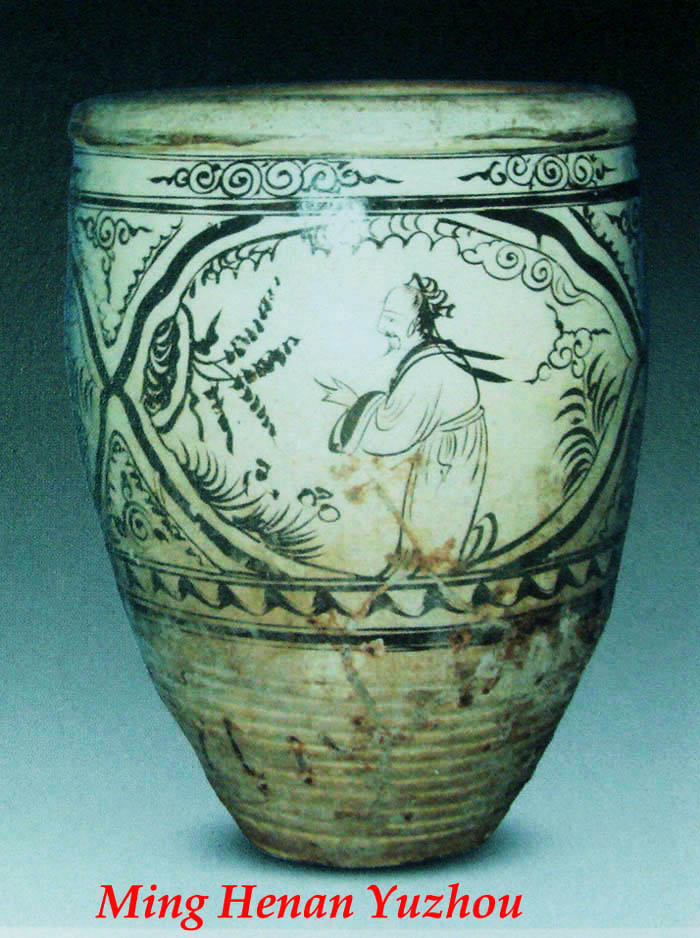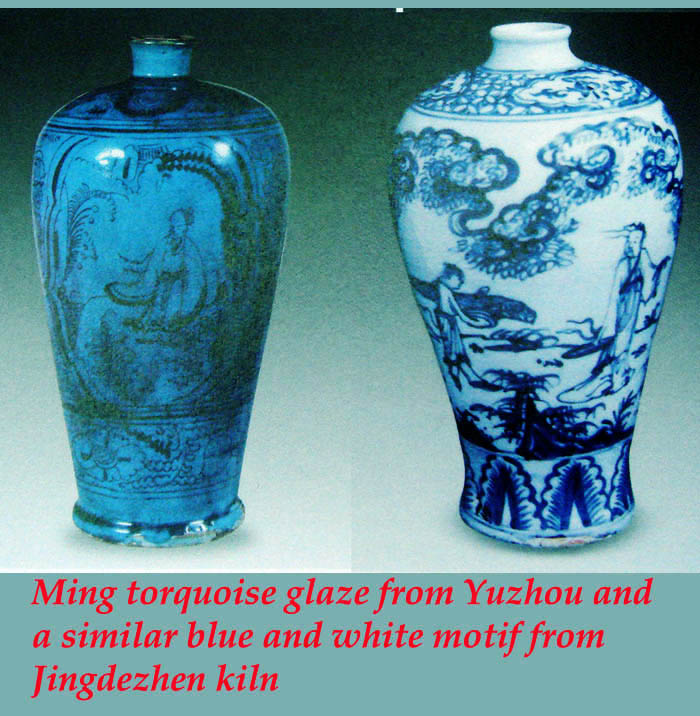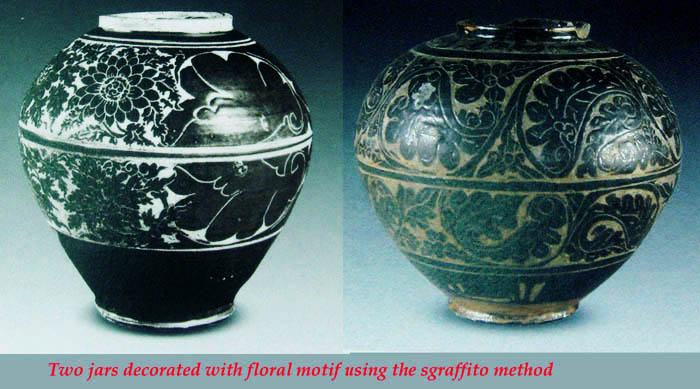
Ming Porcelain
Emergence of Jingdezhen as porcelain production capital
During the Ming Dynasty Jingdezhen firmly established itself as the porcelain production capital of China. The official kiln was established during the Hongwu period. The officiall kiln monopolised the best raw material and manpower to produce porcelain for the palace. Porcelain bearing reign mark was first introduced during the Yongle Period. Blue and white which first appeared during the Yuan Dynasty was further developed and became the dominant product. The best blue and whites were produced during the Yongle and Xuande period using imported cobalt.

Overglaze enamelled (wucai) decoration was improved upon with the finest called Doucai being produced during the Chenghua period. Doucai is characterised by the motif being outline in underglaze blue and the interior filled with overglazed enamels.

Underglaze and monochrome red also saw further development during the Hongwu to Xuande Period.

During the reign of Jiajing, the official kiln on its own was unable to cater to the huge demand of porcelains of the palace. A system called guan da Min shao 官搭民烧(government order people fire) was implemented. Selected commercial kilns were roped in to complete majority of the palace order at a low price. The official kiln essentially ceased production by the Wanli period. Some ceramics scholars however think that a very small number was still produced by official kiln during the Tianqi and Chongzhen period.
For a more detailed discussion on imperial porcelain production, please read this article.
Private kilns blue and white also became very popular in both domestic and export market. To get an overview of non-imperial minyao blue and white, please read this article. To learn even more, especially on dating and authenticating blue and white, please explore this section on folk kiln (minyao) Ming blue and white.
Jingdezhen private kilns also produced the overglaze enamelled wares. By Jiajing period, significant number were exported overseas. Some interesting fragments were found in Shangchuan Island (上川岛)which is located on the southern coast of Guangdong, China. Its name originated from São João ("Saint John" in Portuguese). It was one of the first trading bases established by the Portuguese during the 16th century. They abandoned this base after the Chinese government gave consent for a permanent Portuguese trade base at Macau in 1557.
 |
 |
| Some Jingdezhen examples with overglaze enamelled decoration from Shangchuan Island |
 |
| Jingdezhen non-imperial Hongzhi bowl with overglaze enamelled docoration. |
 |
 |
 |
| Two Jiajing period examples found in Indonesia |
Beside Jingdezhen, Yunnan is another region in China which produced blue and white since the early Ming period. To find out more, please read this article.
Export porcelains
During the early Ming period, private trades with foreigners were banned. The only permitted channel of trade with foreigners was through the tribute system. Severe punishment was meted out on those engaged in illegal smuggling activities with foreigners. The impact of the ban was great. Only small number of export porcelains from the late 14th/15th century were found in Southeast Asia which was once an important oversea market. Thailand and Vietnam made use of the opportunity to fill the demand. This was the golden period for ceramics from the two countries. Many Thai celadon and iron painted wares and Vietnamese blue and white of this period were excavated in Southeast Asia.
Emperor Longqing lifted the foreign trade ban in 1567 A.D. China recaptured the overseas market for porcelains. A significant development was the emergence of demand for blue and white in the European market during the Jiajing period. Some examples of Jiajing blue and white could be found in the San Sebastian shipwreck. The motifs used in those export items were essentially similar to those for the domestic market. The ever increasing demand spurred development of the folk kilns in Jingdezhen. During the Wanli period, blue and white termed kraak wares with customised European design was introduced. The bowls, cups and saucers/chargers are mainly in press-moulded form. The design is characterised by a central motif on the interior base and paneled floral/fauna motifs on the interior wall. Some good examples of kraak porcelains could be found in the Wanli San Diego shipwreck cargo recovered near Manila in Philippines.


Export wares from Fujian Zhangzhou and Dehua
Overseas demand for blue and white was great during the late Ming period. Jingdezhen by itself was unable to meet the demand of the overseas customers. Many kilns located near the coastal ports in China also capitalised on the market demand and produced blue and white. The most important centre was located in Zhangzhou which produced blue and white and enameled wares which was termed Swatow wares. For more regarding Zhangzhou wares, please read this article.
 |
 |
| An example of Zhangzhou blue and white plate from the Binh Thuan wreck. Zhangzhou ware is characterised by the more coarse finishing and grits adhesion on the base. |
Dehua rose to prominent during the late Ming period. It exported a large varieties of wares commonly termed Blanc de chine: cups, censers, gu-vases, ewers, bowls, large plates, lamp, seated lions, figurines. Blanc de chine wares have a silky ivory white tone and the porcelain is translucent. In these aspects, they were different from the early Song/Yuan Dehua wares with the yellowish white glaze. Dehua potters introduced the blanc de chine wares during the 16th century firstly mainly for the Southeast Asian market. During the 17th/18th century, many Dehua blanc de chine were exported to Europe. Dehua ivory colour tone blanc de chine received considerable favouable responses in Europe and were widely collected by royal families and nobles.

Longquan celadon wares
The Ming official records, Da Ming Huidian (大明会典) recorded instances of the Palace ordering Raozhou (饶州) ie Jingdezhen and Chuzhou (处州) to produce porcelain wares for use by Palace and for ritual and overseas tribute purposes. The Longquan kiln site was finally discovered in Dayao Feng DongYan (大窑枫洞岩) and officially excavated in 2006.
According to Da Ming Huidian, the vessels made for the palace were based on form and design specified by the Palace. The excavation confirmed that the vessel forms and designs were similar to those Imperial Ming blue and white wares made at Jingdezhen during the Hongwu and Yongle period. The potting and the quality of the carving of motif on the pieces are excellent. They have a whiter and finer paste and high fired. It has a more light greyish green and the multi-layered glaze more transparent. As there was clear official involvement in the production process, the kiln at Feng Dongyan is confirmed to be the site that produced Ming Longquan Guan wares. Based on the Ming records, by beginning of Chenghua period, Longquan no longer produced imperial wares for the palace.
 |
 |
| Comparison of Longquan and Jingdezhen examples. For those made for the Palace, the decorations followed that used on Imperial Blue and white. |
Longquan celadon ware which was one of the most important export porcelain during the Song/Yuan period continued to be produced but on a much reduced scale. The imposition of foreign trade ban during the Hongwu period severely impacted its production for overseas market. Some were exported through smuggling activities but based on the findings from shipwreck cargoes dated to end of 15th cent., such as the Lena cargo found in the Palawan straits in Philippines, Jingdezhen blue and white had replaced it as the most demanded export ceramics. Lena cargo consisted of mainly Jingdezhen blue and white. Only a small numbers of Longquan celadon wares, mainly big plates were among the finds.
 |
 |
By the 16th century, the production in Longquan was relatively small. But some kilns in Guangdong and Fujian continued to produce Longquan inspired celadon ware during the late Ming Period. Guangdong Dapu Yuli kiln (广东大浦余里窑) was one which there are more information on its products.
 |
 |
 |
 |
 |
| Some Dapu Yuli kiln rejects in Dapu Museum |
Cizhou wares
Cizhou wares from Northern China continued to be popular but was mainly produced for domestic consumption. However, a small number found their way to foreign lands. Some of them could be seen in the Indonesia Jakarta museum.

The main production centres were in Hebei Handan Pengcheng (彭城), Henan Yuzhou (禹州)and Shanxi province. The most common decorative technique is underglaze iron black and/or iron brown motif. On pots, jars and vases, the main motifs are usually depicted within several windows separated by floral scrolls or cloud-like spirals The motifs are executed using calligraphic like strokes. Visually they appear spontaneous, lively and vigorous.







Henan Yuzhou also produced those with iron black motif with a torquoise glaze. Some of the motifs used by the Cizhou potters were similar to those produced in Jingdezhen. For example, compare motif in the below meipings.

There were also those decorated with overglaze green/red enamelled motif.


Shanxi kilns produced many jars decorated using the sgraffito method. The motif is first incised on the glazed body, followed by the area outside the motif being scrapped away. This creates an embossed motif effect.

written by : NK Koh (21 Sep 2009), updated: 6 Oct 2021